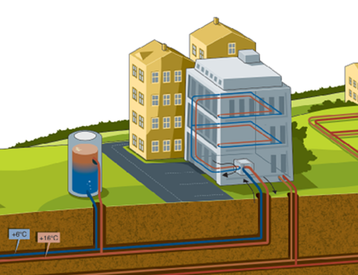Any process that uses energy and converts it to heat (rather than ‘work’) is a candidate for reusing the heat BUT it is only possible if you have an adjacent load that can absorb that heat. A near perfect example is a hospital which uses electricity for lighting and services and space/water heating in equal measures 24x7x365 – hence why CHP (Combined Heat & Power, with electrical power out of the generator and heat out of the engine water jacket etc) can be used successfully.
If you can reuse all the heat (all of the time) then you have halved your carbon footprint and energy bill but you will have had to invest money up-front to achieve that.
Energy density of data centers?
The biggest problem with data centers is that they look like offices from the outside but their energy density is 30 to50 times that of an office space – around 3k to 4k W/m2 for an average European enterprise facility. So, if you want to heat your offices from your data center waste heat then the data center has to be quite small or the offices very large.
What grade is the heat?
The grade (temperature) of the waste heat is low – and can never be higher than 70-75⁰C for liquid cooled processors (a tiny niche so far) or 28-35⁰C for air-cooled (the vast majority). This is a huge problem for exporting the heat over any distance and all heat loads would have to be directly adjacent.
This is unattractive to most data center users: imagine having an anaerobic digester for pig slurry very close next door. The grade of heat is just about suitable for space heating or pre-heating of hot-water domestic services.
How much heat load and at what time?
The typical data center operates 24x7 at (so far) fairly constant load. If your heat load can’t absorb the waste continuously then the financial pay-back quickly fades away.
What sort of load is suitable?
IF your city has the infrastructure for district cooling and heating (e.g. Moscow, Stockholm and other Scandinavian cities) then pulling chilled water into the facility and returning the hot water via a heat exchanger is a no-brainer, although it only works if you have the power station in the city center. However, this is an old solution that has been reversed in many locations., In central London, powerstations have been closed down and converted, into the Tate Modern art gallery (and Battersea power station is in process). The grade of heat in the power station is much higher (~400⁰C) and can be used to drive ammonia based chillers that produce cold-water from heat as well as hot water (or steam) for the locals.
Other loads can include:
- Adjacent hospital or care home (but usually only <500kW)
- Adjacent horticulture in glass-houses (salad crops, marijuana) anaerobic digestion, bio-fuel production
- Pre-heating of industrial process water One possibility is to have many small data centers distributed in the smart city instead of monolithic facilities in remote places where energy is cheap but nobody lives. At 200-300kW each many offices and hotels could absorb high proportions of the waste.
Cooling instead of heating?
See the comments above re ammonia-based absorption chillers – but these usually need higher grade heat, are expensive to install and maintain and have a reputation for being unreliable for continuous usage.
Investment in heat recovery plant?
It costs a lot to install the heat recovery plant. Data centers suffer an endemic problem of partial load so the planning of waste is highly problematical. It is not core business for the data center.
Also look at the consumer of the waste heat, as you may find you are pushed into a large investment which is not your core business. A typical example is a particular large colocation facility in East London, which was forced to install the pipework and heat exchanger as part of the planning permission. As it turned out, none of the adjacent apartments (and there were many built afterwards) showed any commercial interest in using a district heating scheme. The facility now uses around 70MW of power and no amount of local heating load could absorb anywhere near that!
Operational costs?
It costs money to recover the heat in extra maintenance. It is not core to the data center business and, in theory at least, could negatively impact the reliability/availability.
The real ‘excuse’ is that energy effectiveness is NOT a key driver for data centers. Consider the ‘average’ UK enterprise data center: 1kWh of energy passing through a server costs the user about £0.17 in electricity (10p/kWh x PUE of 1.7) but that £0.17 enables £130 worth of business.
For banking and finance, that figure is much higher. The point is that the cost of energy is not a #1 agenda item for most users.



